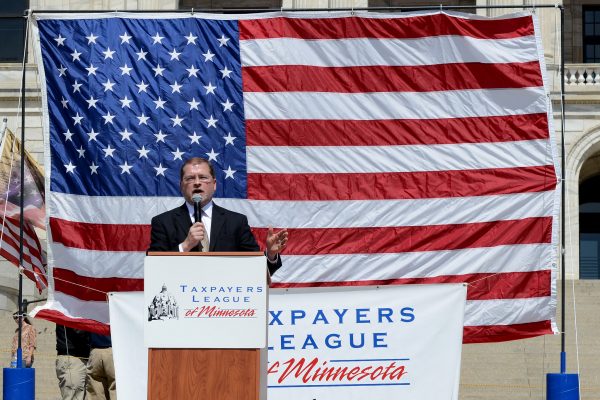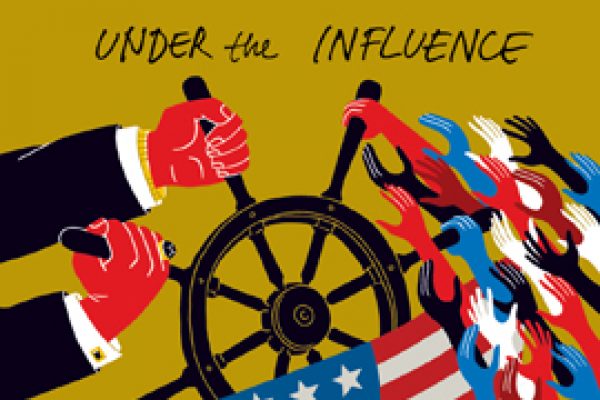Most Americans believe that economic inequality is too high, and many think that higher taxes are the answer. There is some disagreement about who should pay higher taxes, but there is broad agreement about who should not. At least since the heyday of the Occupy Wall Street movement, “We Are the 99 Percent” has been the dividing line.
“Those in the 1 percent are walking off with the riches, but in doing so they have provided nothing but anxiety and insecurity to the 99 percent,” explained Nobel laureate Joseph Stiglitz in his 2012 book The Price of Inequality. The “main fault line in the American society is . . . between the 1 percent and everybody else,” insisted celebrated economists Emanuel Saez and Gabriel Zucman in their book The Triumph of Injustice, published amid the 2020 presidential campaign. Dramatic wealth tax proposals by Democratic presidential candidates Senators Bernie Sanders and Elizabeth Warren, chair of the tax-writing committee Senator Ron Wyden, and even an income taxation plan by Representative Alexandria Ocasio-Cortez do not come close to hiking taxes on anyone below the 1 percent threshold. The same is true of the suggestions by numerous tax academics considering how to tax the rich.
But there are plenty of reasons to expand the conversation about higher taxes to some of those in the 99 percent—specifically those with incomes in the 90th to 99th percentile. Let us call them the affluent. These Americans belong to households making between approximately $150,000 and $500,000 a year. A family needs to earn more than twice the median income to join the affluent circle, and those in its upper echelon earn seven times the median. Yet as concerns about inequality have saturated public and academic discourse, the affluent have stayed out of the spotlight. They are not that rich, after all; they are the 99 percent.
There is no doubt that those in the top 1 percent are the winners in today’s economy. But there is plenty of evidence to suggest that they are not the only winners. Whether we consider income, wealth, opportunity, political influence, tax policy, or cultural resonance, the case for higher taxes on the affluent as well as the 1 percent is much stronger than current political discussion suggests. Inequality is indeed a serious problem, and higher taxes are needed to address it. But it is misguided to focus all attention solely on the top 1 percent.
Start with incomes. A decade ago Anthony Atkinson, Thomas Piketty, and Saez argued that market income of the top 1 percent underwent a staggering threefold increase—from about 8 percent in the 1970s to almost 25 percent by 2004. More recent estimates from the same research group (now joined by Zucman and others) are less stark. Gerald Auten and David Splinter believe that even these later estimates overstate the case, and argue that between 1979 and 2019, the top 1 percent income share rose from a bit over 9 percent to just below 14 percent. This debate, however, is not about growth: only about the extent of that growth. There is no question that the 1 percent have captured a large additional chunk of national income since the days of the Reagan presidency.
The 1970s had lower income inequality than any other time in the United States. To examine the difference between the lowest low and the highest high, that decade would be a logical reference point. But if one was interested in the overall inequality picture, the 1970s would not be the most plausible point of comparison.
The U.S. income tax data underlying all inequality research are available from 1913. But the first half of the twentieth century was full of idiosyncratic events that produced tremendous volatility in income shares: the Roaring Twenties, the Great Depression, and World War II. Income shares stabilized after that, so what happened during the seven-plus postwar decades?
It turns out that most one-percenters have not done particularly well since then. The latest data made publicly available by Piketty, Saez, and Zucman show that the income share of those in the bottom nine-tenths of the top 1 percent (the 99th to 99.9th percentiles) hovered around 10 percent between the end of the war and the early 1950s, dropped to 7 percent during the 1970s, and today is back to just over 10 percent. This is hardly an enviable performance.
In contrast, two other groups did increase their income shares. At the very top, the upper 0.1 percent’s income share grew by just under 4 percentage points over the same period. But income share of the affluent grew even more—by 5 percentage points. Of the three groups—the affluent, the bulk of the one-percenters, and the top 0.1 percent—the affluent captured the greatest additional share of national income since the end of World War II.
To be clear, on a relative scale, the top 0.1-percenters vastly outperformed the affluent. Still, in terms of the additional chunks of overall income that each group captured in the postwar era, the affluent captured the most. At the same time, all lower-income groups have seen only stagnation or decline.
Income share changes are not the only reason to question the “We are the 99 percent” meme. As economist David Autor explains:
The increase in the earnings gap between the typical college-educated and high school-educated household earnings levels is four times as large as the redistribution that has notionally occurred from the bottom 99% to the top 1% of households. What this simple calculation suggests is that the growth of skill differentials among the ‘other 99 percent’ is arguably even more consequential than the rise of the 1% for the welfare of most citizens.
Autor also shows that much of the college wage premium is actually post-college wage premium. Starting in the 1980s, the holders of advanced and professional degrees saw their earnings take off. In 2020 these high earners comprised about 15 percent of the U.S. workforce. Many of these educated Americans are among the affluent.
Most income inequality studies, including all mentioned thus far, trace incomes rather than people. This can make an enormous difference. Imagine a tiny society with ten right-handers and ten left-handers. This society exists for four years, and we observe changes in incomes of its members without knowing who earned what. We see ten incomes of $1 in each of the four years. We also see ten incomes of $10 in the first year, $20 in the second, $30 in the third, and $40 in the fourth. Looking at income shares shows a stark increase in inequality.
We then look at people’s earning histories rather than incomes. It turns out that each of the ten right-handers earned $1, $20, $30, and $1 during the four-year span, while each of the ten left-handers earned $10, $1, $1, and $40. There is no inequality of lifetime earnings at all—every member of this imaginary society earned $52 overall.
This is a highly unrealistic example, but it conveys a real point. Even though it is more difficult to trace people’s earnings than abstract income shares, it is the former that reveals what is happening with inequality.
Subscribe to our newsletter to get our latest essays, archival selections, and exclusive editorial content in your inbox.
Fatih Guvenen and colleagues recently examined thirty-one-year income trajectories for millions of individuals, tracking how incomes over these long periods (roughly approximating one’s working career) change from one annual cohort to the next. They discovered, first, that for the cohorts that entered the workforce between 1957 and 1967, the cohort-to-cohort income growth was much greater and much more evenly distributed compared to cohorts that entered the workforce after 1967. Researchers also discovered that for the post-1967 cohorts, the rate of cohort-to-cohort income growth of the affluent was very similar to that of the one-percenters. The rest of the workers barely saw any cohort-to-cohort income growth at all.
It is worth keeping in mind that these findings are limited to labor earnings—they do not include capital gains, dividends, and other forms of capital income. Capital income is concentrated at the top, so looking only at labor earnings does not reveal the full picture. But there is little doubt that the affluent have seen their lifetime labor earnings rise enough to put the question of whether they—and not only the one-percenters—should pay higher taxes squarely on the table.
So is the “main fault line in the American society . . . between the 1% and everybody else,” as Saez and Zucman insist? Income data, including their own, make this line rather fuzzy. There is no doubt that top 1 percent of incomes have gone up, mostly due to a sharp rise of the top 0.1 percent of the distribution. But the affluent have done quite nicely as well. If one decided to increase redistribution from the top, there’s no reason to exclude the affluent from consideration.
If income data do not rule out taxing the affluent more, perhaps wealth estimates do? These estimates, one should keep in mind, are highly uncertain. Anmol Bhandari and coauthors found that the survey data underlying wealth estimates is so unreliable as to suggest giving up on the whole wealth-estimation enterprise. Still, multiple research groups—both in the government and in academia—estimate wealth distribution, so it is worth looking at how the one-percenters and the affluent fare by comparison.
The findings broadly support two conclusions. First, in the past four decades, the wealth share of the affluent has barely changed while the wealth share of the one-percenters has grown by 50 percent—a major difference. Second, the affluent hold more wealth than the one-percenters do. The difference is small according to Saez and Zucman (36.5 percent for the affluent versus 34.9 percent for the one-percenters), and quite significant according to the Joint Committee on Taxation (38.4 percent for the affluent versus 30.8 percent for the one-percenters), with other estimates falling in between.
To appreciate the significance of the second conclusion, keep in mind that tax revenue equals the tax rate times the tax base. What’s true of Willy Sutton is true of the government as well: it makes sense to look for money where money is. And the wealth data clearly tell us that there is a lot of money to be taxed—and a lot of revenue to be raised—by taxing the wealth of the affluent.
Of course, there are more affluent than there are one-percenters—exactly nine times more—so the individual wealth of the affluent is lower by comparison. But the affluent hold not only more wealth than the small group above them, but also more than everyone below them in the wealth distribution combined. That the one-percenters are wealthier than the affluent on an individual basis suggests that if we decided to tax wealth or wealth accumulation more than we do today, the one-percenters should face a higher tax rate than the affluent. But that does not mean that the rate for the affluent should be zero.
Income and wealth inequality are surely important, but there is more to the inequality story than income and wealth. Social mobility is another vital economic indicator, and it offers more reasons to tax the affluent. The United States is often lauded as the land of opportunity, and the quantitative measure of opportunity is mobility. Returning to our imaginary society of ten right-handers and ten left-handers, it is easy to see that what looks like a startling increase in income inequality at first glance may turn out to be wholly imaginary if mobility is very high—everyone in that society earned $52 over four years. But what if, instead, right-handers were stuck at the bottom, earning $1 each year, while left-handers entrenched themselves at the top and saw their earnings skyrocket from $10 to $20, $30, and $40? Then annual snapshots of the income distribution made famous by Piketty and Saez really would convey a true picture of society’s economic condition, and inequality really would explode.
Until recently the study of economic mobility was hampered by severe data limitations. The main source of workers’ multiyear earning histories had few upper-income taxpayers and none with very high incomes. Only more recent work, using tax returns and Social Security records, has removed the veil from career-long incomes of high earners. The new data reveal that top 1 percent incomes are fleeting. As Auten, Geoffrey Gee, and Nicholas Turner discovered, only half of one-percenters remain in that group after just two years, and that share falls to somewhere between one-third and one-quarter after five. Membership in the affluent group is considerably more stable. Moreover, when one-percenters drop out of the top 1 percent they usually end up among the affluent. In life—as opposed to on a spreadsheet—the line between the 1 percent and the next nine is blurry.
Auten and Gee also found that relative mobility—an indicator showing how many individuals changed their economic position over time compared to their contemporaries—has declined slightly since the mid-1980s. That decline was explained entirely by lower downward mobility at the top: downward mobility declined for the top 10 percent and the top 5 percent, but not for the top 1 percent. The affluent have been more successful in entrenching their economic advantage than the one-percenters.
This self-perpetuation of affluence is even more troubling because it spans generations. U.S. intergenerational economic mobility is one of the lowest among developed countries while U.S. inequality is among the highest. The late Alan Krueger, a Princeton economist and the Assistant Secretary of the Treasury for Economic Policy in the Obama administration, called the cross-country correlation between inequality and mobility the Great Gatsby curve. He also argued that this correlation is not accidental—higher inequality causes lower mobility. And given the decades-long increase in U.S. inequality, Krueger thought that a precipitous decline in U.S. social mobility was imminent.
But mobility did not decline. Studying millions of individual tax returns, Raj Chetty and his colleagues discovered the likely reason for Krueger’s misprediction. “Much of the increase in inequality has been driven by the extreme upper tail,” Chetty’s team explains. But “there is little correlation between mobility and extreme upper tail inequality—as measured, for example, by top 1 percent income shares. Instead, the correlation between inequality and mobility is driven primarily by ‘middle class’ inequality,” by which the authors mean inequality within the entire bottom 99 percent.
Miles Corak—the economist who is often credited with discovering the Great Gatsby curve—wanted to understand why Americans and Canadians experience such stark differences in intergenerational mobility. Though the two countries are similar in many respects, intergenerational mobility is almost twice as high in Canada as it is in the United States. This difference, Corak discovered, “has little to do with the degree of mobility of children raised by families in broad swaths of the middle part of the distribution. . . . [Rather, it] is at the extremes of the distribution that the two countries differ.” At the upper end, it is the lower intergenerational mobility of the top 10 percent of earners that sets Canada and the United States apart. In the United States, those born into the top decile most often stay in the top decile.
So what does it mean that much of the difference between high-mobility-low-inequality Canada and low-mobility-high-inequality United States comes from the lower U.S. mobility in the top 10 percent, while there is no correlation between mobility and inequality measured as the share of the one-percenters’ incomes? The obvious overlap between Corak’s top 10 and Chetty’s bottom 99 percent are the affluent. They have successfully passed their economic advantages to their kids, possibly more successfully than the one-percenters have.
The crucial economic indicators such as income, wealth, and mobility already justify including the affluent in future tax increases; political indicators offer further reasons. There is no shortage of commentators who blame the one-percenters for the sorry state of U.S. politics. “Extreme inequality poses a serious risk to our democracy,” Saez and Zucman argue. “Rich People Rule,” proclaims political scientist Larry Bartels in the Washington Post. What evidence supports these and many similar claims?
To figure out if any particular income group controls the U.S. political system, researchers need to learn the preferences of different groups and compare them to enacted legislation. The trouble is that it is difficult to learn the preferences of those in the 1 percent. They are busy, private, and hard to reach. To my knowledge, the single effort that has succeeded thus far is a study of eighty-three Chicago-area one-percenters by Benjamin Page, Bartels, and Jason Seawright. This study, however, does not solicit views of the affluent, making it impossible to do a head-to-head comparison.
Martin Gilens and Page analyzed a much larger dataset of Americans’ views on a broad range of issues. The researchers concluded that economic elites have a major influence on government policy. But they also acknowledged that the question of “exactly which economic elites (the ‘merely affluent’? the top 1 percent? the top one-tenth of 1 percent?) have how much impact upon public policy, and to what ends they wield their influence” remains unanswered. Quantitative political science research offers little evidence to pin the blame on the one-percenters to the exclusion of the affluent.
Any policy debate about future taxes must consider existing ones. Could the strongest reason for the 1-percent-versus-the-rest divide come from the tax system itself?
Our tax system does favor the rich. It allows billionaires such as Larry Ellison to buy a Hawaiian island, among many other things, while reporting almost no income to the IRS because he does not sell any of his Oracle stock. It allows some private equity fund managers to earn over a billion dollars a year while paying taxes at a low capital gains rate. And it allows billions of dollars in gains to disappear into the ether when appreciated property is passed on to heirs or donated to tax-exempt institutions. One-percenters are the beneficiaries of all these favors and then some. This is why, the argument goes, we should tax them more while leaving everyone else alone.
These are good points, with the exception of the last one. If the features of our tax system just mentioned are indeed its shortcomings, these shortcomings have two causes. First is the low statutory tax rate on long-term capital gains. Second is taxpayers’ ability to defer these gains for many years and possibly forever. To benefit from these tax advantages, taxpayers need to own appreciated assets. The argument that the “main fault line in the American society is . . . between the 1 percent and everybody else” would hold if one-percenters own many more appreciated assets than anyone below them—but do they?
Asset appreciation is not reported to the government unless the asset is sold. For illiquid assets such as interests in a business, an investment partnership, art, or real estate, owners themselves may not have a good idea of what the assets are worth. The Survey of Consumer Finances (SCF) solicits people’s estimates of their holdings in various categories, and research shows that higher-wealth respondents overstate the value of their possessions, making wealth inequality appear greater than it is. For all these reasons, estimating accrued but unrealized gains is extremely challenging, which is why very few estimates exist.
One rough estimate based entirely on the SCF data suggests that one-percenters hold almost half of all unrealized capital gains while the affluent hold about one-third. A more rigorous effort relying on the SCF, tax, and census data reveals a different relationship. That estimate shows how income shares of the one-percenters and the affluent would change if we replaced taxable capital gains with accrued (and currently untaxed) ones. For 2016—the last year in that study and one of three years on which the SCF-only estimate is based—the inclusion of accrued gains would add more income to the affluent than it would to the one-percenters. Larry Ellison is very rich, but there are very few Larry Ellisons. The more numerous affluent may well hold more untaxed gains overall than the one-percenters. If so, the affluent should not be categorically excluded from future tax increases.
One further reason to stop giving the affluent a tax pass is to bolster the credibility of arguments for higher taxes on the rich. A vivid image of a one-percenter has been seemingly imprinted in public imagination. The “fossil-fueled plutocrat, the Wall Street fat cat, the callow tech bro, and the rest of the so-called top 1 percent” are the “stock characters” of the U.S. inequality story, wrote Matthew Stewart in 2018. But who are the “stock characters” among the affluent?
As Richard Reeves points out, “pretty much every position in the influencing business is in fact filled by a member of the upper middle class: journalism, academia, research science, advertising, polling, publishing, the media (old and new), and the arts are, almost by definition, upper middle class strongholds.” By “upper middle class” Reeves means those in the 80th to 99th percentile, so he is clearly talking about the affluent. That academics, researchers, and journalists are part of that group has an unsettling implication. By overlooking the possibility that the affluent—and not only the rich—should pay more in taxes, affluent academics, journalists, and public intellectuals categorically exempt their own social and economic group from the same scrutiny to which they subject a different group. This is hardly the best way to strengthen one’s arguments.
Finally, it is worth asking if the affluent are ignored out of political expedience. Higher taxes on the rich are an easier sell politically than higher taxes on the affluent—and the richer the rich, the easier the sell. But even that easier sell turns out to be quite difficult. This could be the ultimate reason for the one-versus-ninety-nine divide. If the goal is to raise taxes on the one-percenters or on their upper crust, it is wise to get the support of the affluent. And to get that support it makes sense to give the affluent a tax pass.
But political expediency is not the point here. Calls for higher taxes on the one-percenters come not only from party platforms, political stump speeches, or legislative proposals. Today a singular focus on this group pervades tax policy conversation at academic conferences and in scholarly journals, books, and magazines. This self-restraint, if it may be so called, is odd. Intellectual timidity is not a trait rewarded in academia. Scholarship is full of proposals that are far less realistic than a tax increase on the affluent.
Piketty himself advocated a global tax on capital, even as he called it a “useful utopia.” James Hines and Kyle Logue argued that an independent agency akin to the Federal Reserve should set the tax rates, which they acknowledged would be “unprecedented in U.S. history.” Lily Batchelder—an influential tax professor and the current Assistant Secretary of Treasury for Tax Policy—urged enactment of a broad inheritance tax to replace the existing estate tax that is itself under a constant threat of repeal. It is unlikely that any of these proposals will turn into legislation. But political impracticability did not prevent these ideas from being advanced, considered, and debated—and rightly so. The same should be true of higher taxes on the affluent.
One tax in particular is ripe for renewed attention. A value-added tax (or a VAT) is a cornerstone of revenue-raising systems in over 160 countries, but is missing in the United States. Democrats have reservations about its regressivity while Republicans are concerned that it is a money machine. A VAT would, indeed, raise a lot of revenue (including from the affluent)—vastly more than the taxes proposed by the leading Democratic politicians. That revenue could be put toward progressive use, increasing both the overall progressivity and the government’s ability to improve the nation’s education, healthcare, and infrastructure. Moreover, there are ways of tweaking a VAT to shift more of its burden to the affluent and the one-percenters. And there are political bargains to be struck, as became clear when congressional Republicans proposed a new tax that was a not-too-distant cousin of a VAT. But for these bargains to arise, the left needs to move beyond its sole focus on the one-percenters or their upper crust. Intellectual discourse is the first place for this move to occur. In due time, politics will follow.
We’re interested in what you think. Send a letter to the editors at letters@bostonreview.net. Boston Review is nonprofit, paywall-free, and reader-funded. To support work like this, please donate here.









